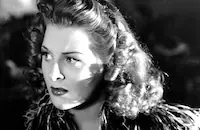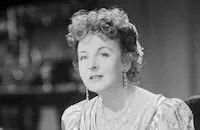The Ghost of Frankenstein

Brief Synopsis
Cast & Crew
Erle C. Kenton
Sir Cedric Hardwicke
Ralph Bellamy
Lionel Atwill
Bela Lugosi
Evelyn Ankers
Film Details
Technical Specs

Synopsis
The villagers of Frankenstein meet in their town hall and proclaim that the hamlet is cursed by the deceased Baron Heinrich Frankenstein, creator of the famed monster. The mayor reminds them that the monster has been killed and that Ygor, the mad doctor's assistant, was "riddled with bullets" by the baron's oldest son Wolf. The townspeople nevertheless decide to destroy Frankenstein's castle, hoping to break the curse, but they inadvertently release the monster from its "grave" in the sulphur pits. The crippled Ygor then decides to take the monster to Dr. Ludwig Frankenstein, the second son of the baron. Ygor and the monster arrive in Ludwig's village of Vasaria, where the monster befriends a young girl named Cloestine Hussman and is then captured by the villagers. When the village prosecutor, Erik Ernst, asks Ludwig to examine a "madman" who has been chained in the police station, the doctor discovers that it is his father's creation. Ygor tells Ludwig that only he can fix the monster's "sick" brain, but Ludwig insists that he wants nothing to do with his family's legacy. The monster is later put on trial, and when Ludwig claims no knowledge of him, the irate creature breaks his chains and, with the help of Ygor, escapes. That night, Elsa Frankenstein sneaks into her father's library and learns of the family secret from her grandfather's diary. Ygor and the monster later go to the Frankenstein villa, where the monster kills Ludwig's assistant, Dr. Kettering. Ludwig captures the monster with the use of sulfuric gas, then promises his daughter that he will find a way to destroy it. Ludwig asks Dr. Theodor Bohmer to help him dissect the monster, a reversal of his father's method of creation, but the insanely jealous surgeon refuses. As he prepares for the dissection, Ludwig is visited by his father's ghost, who asks him to save his life's work by replacing the diseased brain with a new one. Ludwig then decides to replace the monster's brain with that of the recently deceased Kettering. Ygor protests that the operation will cost him "his friend," and offers his own brain instead. When Ludwig refuses, Ygor convinces Bohmer to perform the operation with his brain, offering the physician unlimited power in return. Meanwhile, Erik and the chief constable arrive at the Frankenstein home and insist on searching the estate for the missing Kettering. While they discover numerous secret passageways, they do not find the monster, who is now loose and roaming the village. The monster abducts Cloestine and "tells" Ludwig that he want Cloestine's brain, but with the help of Elsa, the little girl is spirited away. The operation begins, with Bohmer, unknown to Ludwig, using Ygor's brain. Two weeks later, Cloestine's father rallies the townspeople against Frankenstein, but Erik convinces them to let him question the doctor before they act. Ludwig confesses all to the prosecutor, then learns that he has been tricked by Ygor and Bohmer. When the townspeople attack the castle, Ygor, now living inside the monster's body, orders Bohmer to turn on a deadly dose of the sulfuric gas. As Erik rushes off to warn the invaders, Ygor suddenly begins to lose his eyesight. Ludwig informs him that because he and the monster have different blood types, their sensory nerves will not work. The angry Ygor then kills Bohmer, and, in his blind madness, sets the castle on fire, killing himself and Ludwig. Erik and Elsa escape, however, and walk away from the burning castle to face a new life together.

Director
Erle C. Kenton
Cast

Sir Cedric Hardwicke

Ralph Bellamy

Lionel Atwill

Bela Lugosi

Evelyn Ankers
Janet Ann Gallow
Barton Yarborough

Doris Lloyd
Leyland Hodgson
Olaf Hytten

Holmes Herbert

Lon Chaney [jr.]

Lawrence Grant

Brandon Hurst

Dwight Frye
Otto Hoffman
Julius Tannen

Harry Cording
Lionel Belmore
Michael Mark
Dick Alexander
Ernie Stanton
George Eldredge
Jimmy Phillips
Crew
Woody Bredell
Bernard B. Brown
Charles Carroll
W. Scott Darling
R. A. Gausman
Charles S. Gould
Ted Kent
Milton Krasner
Harold H. Macarthur
Jack Otterson
Jack P. Pierce
Charles Previn
H. J. Salter
Eric Taylor
George Waggner
Vera West

Videos
Movie Clip



Film Details
Technical Specs

Articles
The Ghost of Frankenstein
The Ghost of Frankenstein (1942) was the first Universal Frankenstein film that did not star Boris Karloff in role he originally created in the 1931 Frankenstein. In his place was Universal's newest horror star Lon Chaney Jr., the son of the legendary silent movie star Lon Chaney (himself a horror icon for The Phantom of the Opera, 1925, and London After Midnight, 1927). Chaney had appeared in dozens of films before playing Lenny in the big screen version of Of Mice and Men (1939), which immediately elevated his status in Hollywood, and then becoming a horror star in The Wolf Man (1941). For The Ghost of Frankenstein, he donned the heavy costume, elevated boots, and distinctive make-up designed by Universal's make-up wizard Jack Pierce, the man who turned Karloff into the original Frankenstein's monster. By this time Frankenstein's creation had devolved into a lumbering, uncommunicative, unkillable golem but Chaney is given a few scenes of empathy. It's the last film in the classic Universal horror cycle to give the creature a sense of pathos and pity.
Ygor was one of Lugosi's favorite roles and the only iconic horror character the actor created since becoming a star in Dracula (1931). Though he's only fifth-billed in the cast, Lugosi's Ygor dominates the film as both tormented outcast and vengeful villain, cackling with glee while dropping stones on the angry villagers from the castle turret. When Dr. Frankenstein decides to save his father's creation with a brain transplant, Ygor schemes with Frankenstein's bitter assistant (Lionel Atwill) to put his own brain into the hulking, superhuman creature. That twist was played up in the studio marketing, which encouraged theaters to place an empty chair in the lobby with sign reading: "Will you loan me your brain?"
The Ghost of Frankenstein was the final solo Frankenstein sequel. His next appearance was in House of Frankenstein (1944), the first in a series of monster mash team-ups produced on low budgets by the studio's B-movie unit. Ghost is a more modest production than Son and you can see the budgetary constraints in the modest castle in the opening scenes, the less elaborate laboratory set, and the reuse of standing sets. The town square built for All Quiet on the Western Front and recycled for the original Frankenstein is drafted into use once again for the village of Visaria, home to the second son of Frankenstein. And on the subject of recycling, four of the film's stars appeared a year earlier in The Wolf Man (1941), Universal's last original horror hit. Along with Lon Chaney Jr. and Bela Lugosi (who played a small but memorable role as a cursed gypsy), Ralph Bellamy and Evelyn Ankers take on major supporting roles similar. Director Erle C. Kenton, a veteran of Universal's B-movie unit, was a comedy specialist who began as one Mack Sennett's original Keystone Kops, but he did come to the film with a genuine horror movie classic to his credit: the original 1931 Island of Lost Souls.
In the worlds of Lugosi biographer Arthur Lennig, The Ghost of Frankenstein is "a fast-paced, melodramatic sequel that has survived the years satisfactorily... and is the last time that the monster was given the budget, direction, and script that he deserved."
Sources:
The Overlook Film Encyclopedia: Horror, ed. Phil Hardy. The Overlook Press, 1993.
The Immortal Count: The Life and Films of Bela Lugosi, Arthur Lennig. University Press of Kentucky, 2003.
Lugosi, Gary Don Rhodes. McFarland & Company, 1997.
The Frankenstein Files: How Hollywood Made a Monster, documentary directed and written by David J. Skal. Universal Studios Home Video, 2003.
IMDb
By Sean Axmaker

The Ghost of Frankenstein
Quotes
Trivia
Notes
This was the fourth Universal film to feature the "Frankenstein monster," and it followed the storyline established by the previous film, Son of Frankenstein (see AFI Catalog of Feature Films, 1931-40; F3.4191). It was the first Universal "Frankenstein" film, however, in which Boris Karloff did not play the role of the monster. According to Hollywood Reporter, Universal learned in mid-November 1941 that Karloff's commitment to the Broadway play Arsenic and Old Lace would make it impossible for the actor to appear in this production, so Lon Chaney, Jr. was chosen to replace him. In late December 1941, Hollywood Reporter reported that Chaney suffered a severe allergic reaction to the monster makeup used by Jack Pierce and missed several days of shooting. Actors Michael Mark and Lionel Belmore, who play councillors in this film, also appeared in Son of Frankenstein, though their characters were killed in the earlier film. According to modern sources, Universal would not admit to a casting error in this matter, arguing instead that it was a company policy to reuse the same actors in the "Frankenstein" series to maintain a sense of continuity.
According to Universal publicity materials, director of photography Milton Krasner used a one-inch wide angle lens to shoot most of the film. Universal press materials also state that Lon Chaney, who was six feet, three inches tall and weighed 220 pounds, became six feet, nine inches tall and weighed 284 pounds when wearing the monster costume and makeup. Modern sources state that in Eric Taylor's original draft of the film's screenplay, the character of "Wolf von Frankenstein," who was featured in Son of Frankenstein, was revived. In addition, the mad scientist "Theodor Bohmer" was a hunchback, not a physician in the first draft. As the character of "Dr. Kettering" did not exist in the earlier draft, Ludwig used the brain of Cloestine's father, who had been killed earlier by the monster. Theodor made the "brain switch" after the monster accidentally killed Ygor as well. Modern sources also state that Eddie Parker worked as a stuntman on the film and list Teddy Infuhr as a boy in the cast. For more information on films featuring the Frankenstein monster, see the Series Index and the entry for Frankenstein in AFI Catalog of Feature Films, 1931-40; F3.1465.














